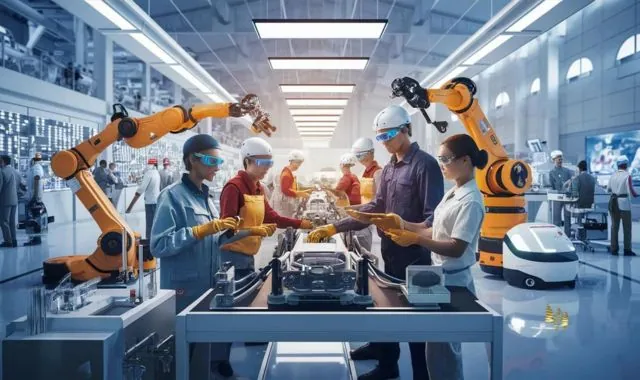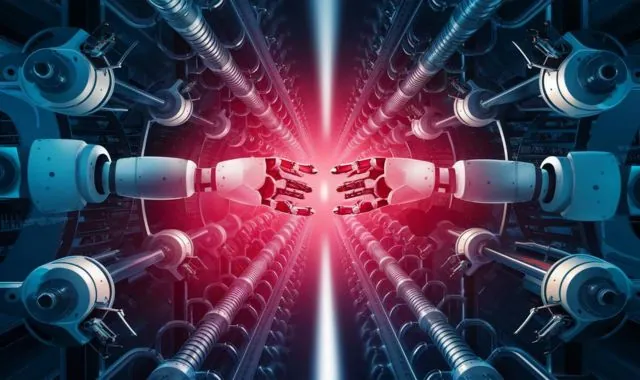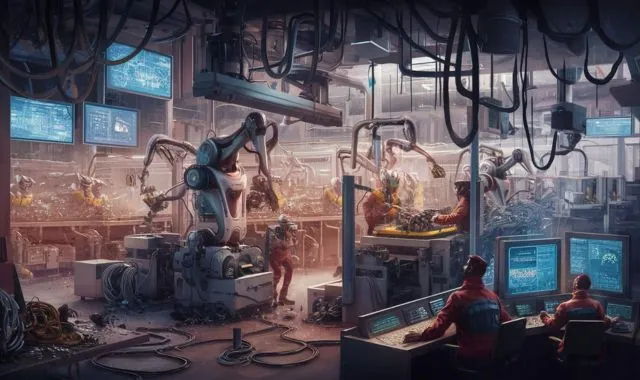Physical Address
304 North Cardinal St.
Dorchester Center, MA 02124
Physical Address
304 North Cardinal St.
Dorchester Center, MA 02124

The Industrial Revolution 2.0 is transforming manufacturing with automation, robots, and smart machines. Factories are becoming connected, efficient, and sustainable. Challenges include cost, cybersecurity, and workforce changes. This technological revolution is paving the way for a future of human-machine collaboration and a thriving manufacturing industry.

The factory floor is no longer a scene from a bygone era. Buckle up, because the Industrial Revolution 2.0 is upon us, and it’s driven by a powerful surge of technological innovation. Get ready to explore the exciting world of smart machines, connected factories, and a future where efficiency and sustainability go hand-in-hand.
Imagine a tireless workforce that never complains and can perform tasks with unmatched precision. That’s the reality of industrial robotics. These automated machines are transforming production lines, handling heavy lifting, welding with laser-like accuracy, and painting with meticulous detail.
Hold onto your hardhats – autonomous systems are here to stay. Factory floors are increasingly adopting self-driving vehicles and robots that can operate independently, performing complex tasks without human intervention. This “lights-out” manufacturing promises not just increased efficiency but also the ability to operate around the clock.
The factory of the future is a symphony of connected machines. Industrial IoT (IIoT) equips machines with sensors that collect real-time data on everything from temperature and pressure to vibration and energy use. This constant stream of information allows for unparalleled monitoring and control.
But data is just information until you unlock its potential. Big data analytics takes the vast amount of data collected by IIoT and transforms it into actionable insights. Predictive maintenance, optimized production schedules, and improved quality control are just a few of the benefits gleaned from this powerful technology.
Ever wondered where your latest gadget is in the production process? The connected supply chain provides complete transparency. With real-time tracking, you can pinpoint the exact location of your products, from raw materials to finished goods, ensuring efficient delivery and informed decision-making.
Imagine a world where your equipment fixes itself before it breaks down. Predictive maintenance, powered by IIoT and data analytics, makes this a reality. By analyzing sensor data, potential equipment failures can be identified and addressed proactively, minimizing downtime and maximizing production efficiency.
The Industrial Revolution 2.0 isn’t just about efficiency; it’s about responsibility. Green manufacturing practices are being integrated into every stage of production, minimizing waste, reducing energy consumption, and utilizing eco-friendly materials.
Energy efficiency is at the forefront of modern manufacturing. Smart factories utilize advanced control systems and renewable energy sources to minimize their environmental impact. This not only benefits the planet but also translates to significant cost savings.
The rise of automation doesn’t spell the end of human jobs – it demands a shift in skillsets. Upskilling and reskilling initiatives are crucial, equipping workers with the necessary expertise to manage complex technologies, analyze data, and ensure smooth human-machine collaboration.
The future of work is one of collaboration, not competition. Humans will continue to play a vital role in design, innovation, problem-solving, and strategic decision-making. Machines, on the other hand, will excel at repetitive tasks, data analysis, and precise execution. It’s a symphony of human and machine intelligence, each complementing the other.
Imagine a factory floor buzzing with activity, not just of machines, but of human-machine partnerships. This is the future of work – a fusion of human ingenuity and machine precision, driving innovation and shaping a more sustainable and efficient industrial landscape.

While the benefits of Industrial Revolution 2.0 technologies are undeniable, the initial investment can be significant. Exploring financing options, cost-benefit analysis, and phased implementation strategies can help ease the financial burden.
A connected factory presents a larger attack surface for cyber threats. Robust cybersecurity measures and protocols are essential to safeguard sensitive data and prevent operational disruptions.
Navigating the transition to a more automated workplace requires careful consideration. Effective communication, training programs, and addressing worker concerns are crucial for a smooth and successful shift.
Highlight real-world examples of companies that have successfully adopted Industrial Revolution 2.0 technologies. These case studies can showcase the tangible benefits of automation, IIoT, and data analytics in various manufacturing sectors.
Delve deeper into how these technologies are impacting specific industries. For instance, explore how 3D printing is revolutionizing prototyping in the automotive industry or how augmented reality is enhancing training procedures in aerospace manufacturing.
Touch upon technologies on the cusp of disrupting the manufacturing landscape further. Artificial intelligence, machine learning, and advancements in robotics hold immense potential for future factories.
As technology becomes more sophisticated, ethical considerations regarding automation and job displacement need to be addressed proactively. Discussions around reskilling initiatives, universal basic income, and the future of work will become increasingly important.

The Industrial Revolution 2.0 is a journey, not a destination. As technology continues to evolve, so too will the factories of tomorrow. By embracing these advancements, we can create a future where industry thrives in harmony with the environment, powered by a skilled workforce and a spirit of human-machine collaboration. The road ahead is brimming with possibilities, and the future of manufacturing is looking brighter than ever.
Here are some frequently asked questions about the Industrial Revolution 2.0:
The Industrial Revolution 2.0 refers to the current wave of technological advancements transforming the manufacturing sector. It’s characterized by automation, robotics, the Industrial Internet of Things (IIoT), big data analytics, and a focus on sustainability.
The future is expected to see further advancements in artificial intelligence, robotics, and human-machine collaboration. There will also be a continued focus on developing sustainable manufacturing practices. The ethical implications of automation will be a crucial area of discussion as technology evolves.
There are many resources available online and in libraries that discuss Industrial Revolution 2.0. You can also find case studies of companies that have successfully implemented these technologies. Industry publications and conferences are another great way to stay up-to-date on the latest trends.